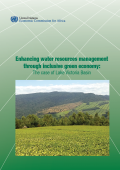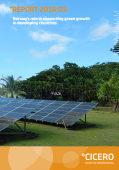
Lake Victoria in East Africa, the world’s second largest lake, is endowed with abundant water and other natural resources. The lake is transboundary and of significance to its basin countries – which are also East African Community (EAC) partner States (Burundi, Kenya, Rwanda, Uganda and United Republic of Tanzania) – and basin communities because of its role in supporting valuable ecosystem services, livelihood systems and economic activities. The basin’s natural resource endowments include water resources (the lake’s estimated volume is 2,700 km3); rivers, streams and wetlands; abundant and fertile land; natural forest resources; minerals; and wildlife, including a high annual fish yield estimated at more than $550 million. It also hosts the crested crane and the globally threatened sitatunga – a swamp dwelling antelope.

Taking into account bilateral political and economic relations, the authors analyze the role of institutional distance and host country attractiveness in location determinants of Chinese Foreign investments in EU in the renewable energy sector. Findings show that Chinese firms tend to invest in EU countries with reduced rule of law; market affluence is an attraction factor for them, but they do not seem to be human capital asset-seekers. Countries with politically stable environment are most attractive to sales/services subsidiaries; while countries with good control of corruption, low trade barriers and encouraging foreign ownership are most attractive to manufacturing subsidiaries. A large market is the most attractive factor for R&D subsidiaries, and a rich market is the most attractive factor for manufacturing subsidiaries. Manufacturing subsidiaries are more technological asset-seekers. R&D subsidiaries are the most non-human capital asset-seekers.

This report discusses green growth in developing countries, and Norway's role supporting such a green development strategy. After defining green growth in the context of developing countries, the report discusses indicators of green growth, barriers, and prominent instruments to facilitate green growth. Two case studies are presented, the first on green bonds in Ethiopia, and the second on introducing a green growth credit mechanism. The report concludes with some general findings, and findings linked to the two case studies.

Laboratory studies suggest that improved cooking stoves can reduce indoor air pollution, improve health, and decrease greenhouse gas emissions in developing countries. The authors provide evidence, from a large-scale randomized trial in India, on the benefits of a common, laboratory-validated stove with a four-year follow-up. While smoke inhalation initially falls, this effect disappears by year two. They find no changes across health outcomes or greenhouse gas emissions. Households used the stoves irregularly and inappropriately, failed to maintain them, and usage declined over time. This study underscores the need to test environmental technologies in real-world settings where behavior may undermine potential impacts.
The policy summary for this paper is available here.
